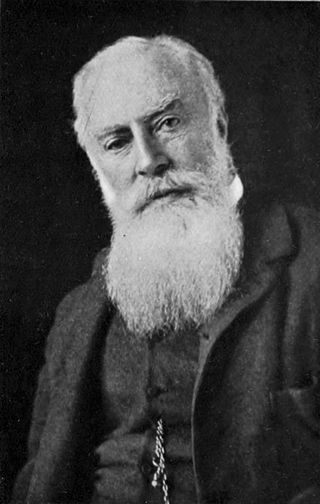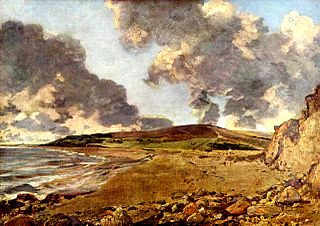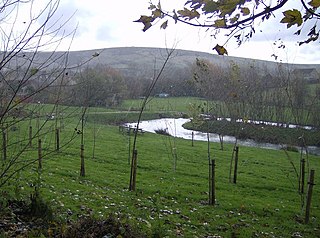
John Constable was an English landscape painter in the Romantic tradition. Born in Suffolk, he is known principally for revolutionising the genre of landscape painting with his pictures of Dedham Vale, the area surrounding his home – now known as "Constable Country" – which he invested with an intensity of affection. "I should paint my own places best", he wrote to his friend John Fisher in 1821, "painting is but another word for feeling".

The Hay Wain – originally titled Landscape: Noon – is a painting by John Constable, completed in 1821, which depicts a rural scene on the River Stour between the English counties of Suffolk and Essex. It hangs in the National Gallery in London and is regarded as "Constable's most famous image" and one of the greatest and most popular English paintings.

Osmington is a village and civil parish within Dorset, England, situated on the Jurassic Coast 4 miles (6.4 km) north-east of Weymouth. In the 2011 census the parish—which includes the small settlements of Upton, Ringstead and Osmington Mills—had a population of 673.

Overcombe is an coastal area in Preston in south Dorset, England, situated on top of cliffs 2 miles (3.2 km) northeast of Weymouth. The River Jordan flows in the vicinity.

The Cornfield is an oil painting by the English artist John Constable, completed from January to March 1826 in the artist’s studio. The painting shows a lane leading from East Bergholt toward Dedham, Essex, and depicts a young shepherd boy drinking from a pool in the heat of summer. The location is along Fen Lane, which the artist knew well. Constable referred to the piece as The Drinking Boy.

The Virgin of the Rocks, sometimes the Madonna of the Rocks, is the name of two paintings by the Italian Renaissance artist Leonardo da Vinci, of the same subject, with a composition which is identical except for several significant details. The version generally considered the prime version, the earlier of the two, is unrestored and hangs in the Louvre in Paris. The other, which was restored between 2008 and 2010, hangs in the National Gallery, London. The works are often known as the Louvre Virgin of the Rocks and London Virgin of the Rocks respectively. The paintings are both nearly 2 metres high and are painted in oils. Both were originally painted on wooden panels, but the Louvre version has been transferred to canvas.

Jordan Hill Roman Temple is a Romano-Celtic temple and Roman ruin situated on Jordan Hill above Bowleaze Cove in the eastern suburbs of Weymouth in Dorset, England. Original amateur archaeological excavations on the site were carried out by J. Medhurst in 1843-6. These were followed by excavations by C.D. Drew and C.S. Prideaux during 1931-32 suggesting that the site was in operation between c. AD 69–79 to the late 4th century. Some of the finds from the excavations in the 1930s are in the Dorset Museum and the British Museum. There are other Roman sites nearby including Preston Roman Villa to the north west.

Weymouth Bay is a sheltered bay on the south coast of England, in Dorset. It is protected from erosion by Chesil Beach and the Isle of Portland, and includes several beaches, notably Weymouth Beach, a gently curving arc of golden sand which stretches from the resort of Weymouth. Weymouth Bay is situated approximately halfway along the UNESCO Jurassic Coast World Heritage Site.

Ringstead is a small seaside village located on the coast in Dorset, southern England. The area lies on the Jurassic Coast and is known for its natural environment and fossils. Ringstead Bay and White Nothe are to the east. Bran Point and Osmington Mills are to the west.
Events in the year 1817 in Art.

Greenhill is a suburb to the northeast of Weymouth in Dorset, England, with a sand and shingle beach.

Bowleaze Cove is a small sand and shingle beach, near the village of Preston, just to the northeast of Weymouth, Dorset, England. The cove is on the Jurassic Coast and is known for its geology. Just to the west is Furzy Cliff.

Osmington Mills is a coastal hamlet in the English county of Dorset. It lies within the civil parish of Osmington 5 miles (8.0 km) northeast of Weymouth.

George Salting was an Colony of New South Wales-born British art collector. He had inherited considerable wealth from his father; Salting collected paintings, Chinese porcelains, furniture, and many other categories of art and decorative items. He left his paintings to the National Gallery, London, prints and drawings to the British Museum, and the remainder to the Victoria & Albert Museum, requesting that the collection be displayed intact rather than divided among the museum's departments.

Salisbury Cathedral from the Bishop's Grounds is an 1823 landscape painting by the English landscape painter John Constable (1776–1837). This image of Salisbury Cathedral, one of England's most famous medieval churches, is one of his most celebrated works, and was commissioned by one of his closest friends, John Fisher, The Bishop of Salisbury. The 1823 version of the painting has been in the collection of the Victoria & Albert Museum in London since its bequest in 1857.

Thomas Watling, was an early Australian painter and illustrator, notable for his natural history drawings and landscapes.

Jordan Hill is located near the coast close to the village of Preston, just to the east of Weymouth, Dorset, England. The hill leads down to Furzy Cliff on the coast to the south. Close by to the east is Bowleaze Cove. The hill figure of the Osmington White Horse can be seen from the hill to the north. There are also views across Bowleaze Cove from the hill and nearby public footpaths. The hill is a short detour from the South West Coastal Path National Trail.

Furzy Cliff, also known as Jordan's Cliff, is located on the coast near the village of Preston, just to the east of Weymouth in Dorset, England. It is at the north-eastern end of Weymouth Beach, looking out over Weymouth Bay to Portland Harbour and the Isle of Portland. Close by to the east is Bowleaze Cove. Just inland to the north are Jordan Hill and the remains of the Jordan Hill Roman Temple. On the top of the cliff there is a large grass area with good views.

The River Jordan is a river in the county of Dorset, England. The river is approximately 3 miles (4.8 km) long, and includes the tributaries of the Osmington Brook and the Preston River. The River Jordan discharges into the English Channel at Bowleaze Cove, northeast of Weymouth.


















